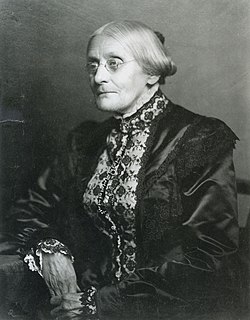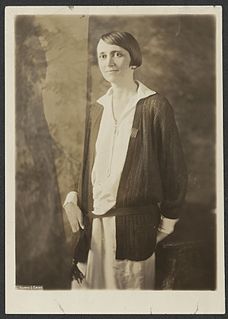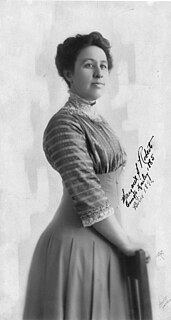Related Research Articles

Susan B. Anthony was an American social reformer and women's rights activist who played a pivotal role in the women's suffrage movement. Born into a Quaker family committed to social equality, she collected anti-slavery petitions at the age of 17. In 1856, she became the New York state agent for the American Anti-Slavery Society.

The Nineteenth Amendment to the United States Constitution prohibits the United States and its states from denying the right to vote to citizens of the United States on the basis of sex, in effect recognising the right of women to a vote. The amendment was the culmination of a decades-long movement for women's suffrage in the United States, at both the state and national levels, and was part of the worldwide movement towards women's suffrage and part of the wider women's rights movement. The first women's suffrage amendment was introduced in Congress in 1878. However, a suffrage amendment did not pass the House of Representatives until May 21, 1919, which was quickly followed by the Senate, on June 4, 1919. It was then submitted to the states for ratification, achieving the requisite 36 ratifications to secure adoption, and thereby go into effect, on August 18, 1920. The Nineteenth Amendment's adoption was certified on August 26, 1920.

Elizabeth Cady Stanton was an American writer and activist who was a leader of the women's rights movement in the U.S. during the mid- to late-19th century. She was the main force behind the 1848 Seneca Falls Convention, the first convention to be called for the sole purpose of discussing women's rights, and was the primary author of its Declaration of Sentiments. Her demand for women's right to vote generated a controversy at the convention but quickly became a central tenet of the women's movement. She was also active in other social reform activities, especially abolitionism.

The Equal Rights Amendment (ERA) is a proposed amendment to the United States Constitution designed to guarantee equal legal rights for all American citizens regardless of sex. Proponents assert it would end legal distinctions between men and women in matters of divorce, property, employment, and other matters. The first version of an ERA was written by Alice Paul and Crystal Eastman and introduced in Congress in December 1923.

The National American Woman Suffrage Association (NAWSA) was an organization formed on February 18, 1890, to advocate in favor of women's suffrage in the United States. It was created by the merger of two existing organizations, the National Woman Suffrage Association (NWSA) and the American Woman Suffrage Association (AWSA). Its membership, which was about seven thousand at the time it was formed, eventually increased to two million, making it the largest voluntary organization in the nation. It played a pivotal role in the passing of the Nineteenth Amendment to the United States Constitution, which in 1920 guaranteed women's right to vote.

The League of Women Voters (LWV) is a nonprofit organization in the United States that was formed to help women take a larger role in public affairs after they won the right to vote. It was founded in 1920 to support the new women suffrage rights and was a merger of National Council of Women Voters, founded by Emma Smith DeVoe, and National American Woman Suffrage Association, led by Carrie Chapman Catt, approximately six months before the Nineteenth Amendment to the United States Constitution gave women the right to vote. The League of Women Voters began as a "mighty political experiment" aimed to help newly enfranchised women exercise their responsibilities as voters. Originally, only women could join the league; but in 1973 the charter was modified to include men. LWV operates at the local, state, and national level, with over 1,000 local and 50 state leagues, and one territory league in the U.S. Virgin Islands. The league states that it has over 500,000 members and supporters.

Abigail Scott Duniway was an American women's rights advocate, newspaper editor and writer, whose efforts were instrumental in gaining voting rights for women.

Alice Stokes Paul was an American Quaker, suffragist, feminist, and women's rights activist, and one of the main leaders and strategists of the campaign for the Nineteenth Amendment to the U.S. Constitution, which prohibits sex discrimination in the right to vote. Paul initiated, and along with Lucy Burns and others, strategized events such as the Woman Suffrage Procession and the Silent Sentinels, which were part of the successful campaign that resulted in the amendment's passage in 1920.

Henry Browne Blackwell, was an American advocate for social and economic reform. He was one of the founders of the Republican Party and the American Woman Suffrage Association. He published Woman's Journal starting in 1870 in Boston, Massachusetts with Lucy Stone.

The National Woman's Party (NWP) was an American women's political organization formed in 1916 to fight for women's suffrage. After achieving this goal with the 1920 adoption of the Nineteenth Amendment to the United States Constitution, the NWP advocated for other issues including the Equal Rights Amendment. The most prominent leader of the National Woman's Party was Alice Paul, and its most notable event was the 1917–1919 Silent Sentinels vigil outside the gates of the White House. As of January 1, 2021, NWP has ceased operations as its own independent non-profit and has assigned its trademark rights and other uses of the party's name to the Alice Paul Institute. The Alice Paul Institute has invited three members of NWP Board of Directors to join their board and in the near future will created a new committee to "advise on a potential expansion of programs to the Washington, DC area and nationally".

Women's legal right to vote was established in the United States over the course of more than half a century, first in various states and localities, sometimes on a limited basis, and then nationally in 1920.

Anne Dallas Dudley was an American activist in the women's suffrage movement. She was a national and state leader in the fight for women's suffrage who worked to secure the ratification of the 19th Amendment in Tennessee. After founding the Nashville Equal Suffrage League and serving as its president, she moved up through the ranks of the movement, serving as President of the Tennessee Equal Suffrage Association and then as Third Vice President of the National American Woman Suffrage Association, where she helped lead efforts to get the Nineteenth Amendment to the US Constitution ratified, giving women the right to vote nationwide. She is especially noted for her successful efforts to get the Nineteenth Amendment ratified in her home state of Tennessee, the final state necessary to bring the amendment into force.

Susan B. Anthony Day is a commemorative holiday to celebrate the birth of Susan B. Anthony and women's suffrage in the United States. The holiday is February 15—Anthony's birthday.

Sue Shelton White, called Miss Sue, was a feminist leader originally from Henderson, Tennessee, who served as a national leader of the women's suffrage movement, member of the Silent Sentinels, editor of The Suffragist.

Elsie Hill was an American suffragist, as were her sisters Clara and Helena Hill.

The Minnesota Woman Suffrage Memorial, located in the grounds of the Minnesota State Capitol in Saint Paul, Minnesota, commemorates 25 women whose achievements were important to the Minnesota Woman Suffrage Association (MWSA).

Wyoming was the first place in the world to give all women the ability to vote, although other jurisdictions had already given limited suffrage to women who met various property qualifications. A U.S. territory in 1869, Wyoming's first territorial legislature voted to give women the right to vote and to hold public office. A legislature made entirely of men passed the woman's suffrage bill in 1869 entitled "An to Grant to the Women of Wyoming Territory the Right of Suffrage, and to Hold Office.” The territory retained its woman suffrage law even when that law could have jeopardized the Wyoming Territory's application for statehood. In 1890, Wyoming became the first U.S. state allowing its woman citizens to vote.
Women's suffrage in California refers to the political struggle for voting rights for women in the state of California. The movement began in the 19th century and was successful with the passage of Proposition 4 on October 10, 1911. Many of the women and men involved in this movement remained politically active in the national suffrage movement with organizations such as the National American Women's Suffrage Association and the National Woman's Party.

Women's suffrage in Nevada began in the late 1860s. Lecturer and suffragist, Laura de Force Gordon, started giving women's suffrage speeches in the state starting in 1867. In 1869, Assemblyman Curtis J. Hillyer introduced a women's suffrage resolution in the Nevada Legislature. He also spoke out on women's rights. Hillyer's resolution passed, but like all proposed amendments to the state constitution, must pass one more time and then go out to a voter referendum. In 1870, Nevada held its first women's suffrage convention in Battle Mountain Station. In the late 1880s, women gained the right to run for school offices and the next year several women are elected to office. A few suffrage associations were formed in the mid 1890s, with a state group operating a few women's suffrage conventions. However, after 1899, most suffrage work slowed down or stopped altogether. In 1911, the Nevada Equal Franchise Society (NEFS) was formed. Attorney Felice Cohn wrote a women's suffrage resolution that was accepted and passed the Nevada Legislature. The resolution passed again in 1913 and will go out to the voters on November 3, 1914. Suffragists in the state organized heavily for the 1914 vote. Anne Henrietta Martin brought in suffragists and trade unionists from other states to help campaign. Martin and Mabel Vernon traveled around the state in a rented Ford Model T, covering thousands of miles. Suffragists in Nevada visited mining towns and even went down into mines to talk to voters. On November 3, the voters of Nevada voted overwhelmingly for women's suffrage. Even though Nevada women won the vote, they did not stop campaigning for women's suffrage. Nevada suffragists aided other states' campaigns and worked towards securing a federal suffrage amendment. On February 7, 1920, Nevada became the 28th state to ratify the Nineteenth Amendment.

Margaret Stevenson Roberts was an American librarian known as Idaho's "Petticoat Governor" for her influence in advocating for women's suffrage. She was the main force behind the Idaho Free Traveling Library for over thirty years, encouraging reading and the establishment of public libraries.
References
- 1 2 3 4 "Miss Fannie M. Irvin". The Marshall News Messenger. 15 October 1929. p. 3.
- 1 2 3 4 5 Binheim, Max; Elvin, Charles A (1928). Women of the West; a series of biographical sketches of living eminent women in the eleven western states of the United States of America. p. 123.
 This article incorporates text from this source, which is in the public domain .
This article incorporates text from this source, which is in the public domain . - 1 2 "Miss Fanny Irvin Called by Death At Her Home Here". Idaho Statesman. 15 October 1929. p. 9.